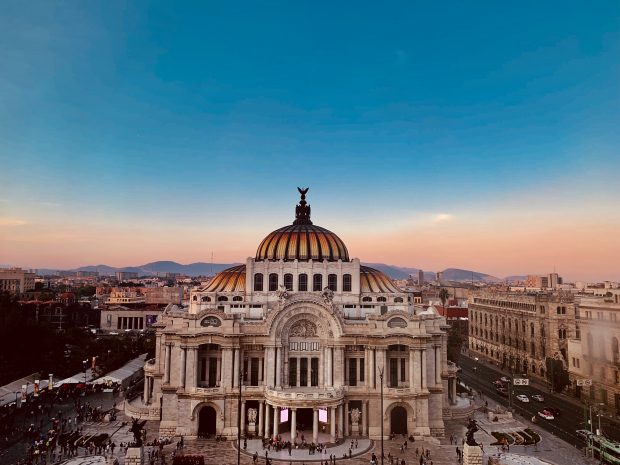The French Connection: Mexico and France’s Interwoven History Finds a New Expression at the Sofitel Mexico City Reforma
Take yourself back in time and imagine a classic Parisian vignette in the early 1900s. In this era, Art Deco and Art Nouveau architecture added an air of opulence to every turn. Tree-lined boulevards bustled with well-heeled couples stopping to enjoy an afternoon aperitif while discussing the latest French literature and fashions. It’s a heady scene, and one that captured the global imagination. “Paris was where the Twentieth Century was… was the place to be,” declared American novelist and poet Gertrude Stein. All eyes looked to this elegant cultural capital for inspiration — including those of Mexico’s then-president, Porfirio Diaz.
Diaz tasked himself with trying to unite and modernize Mexico. Although Mexico fought the French in the War of the Reform, Diaz thought France as the perfect example for Mexico. During this time, referred to as El Porfiriato, Diaz commissioned the construction of many French-inspired buildings. This included theatres, monuments, and elegant department stores modelled on the boutiques of Paris. These multi-level stores that hummed with sophistication brought dressmakers and styles from Paris. This allowed upper-class Mexicans to deck themselves out in garments worn by the fashionistas of Europe. Several of Mexico City’s finest colleges even taught French as the first language.
Modern Day French Art Deco in Mexico
More than a century later, it doesn’t take long to spot the French influence when exploring Mexico City. The Palace of Fine Arts (Palacio de las Bellas Artes) is a stunning example of Art Nouveau architecture that would be right at home among the avenues of central Paris, and even when the Folkloric Ballet (a performance of traditional Mexican dance) is on stage, the building’s Art Deco interior evokes images of the City of Light at the height of its glamour. You might also spot the Parisian-style metro sign, just alongside Bellas Artes.
Parisian-style architecture dotted the streets of the capital’s most chic neighborhoods, Roma, Condesa, and Juarez. The al fresco cafés that line their sidewalks give these neighborhoods a similar energy to Paris’s Latin Quarter. These cafés provide equally enticing opportunities for people-watching. Favorites include Café Toscano on Roma Norte’s delightful Plaza Rio de Janiero, a prime spot for watching the city’s trendiest residents (and their many dogs) go by; Café Nin in La Juarez (make sure to try their famous rol de guayaba); Maque in La Condesa, a more traditional café and cake shop; or the infamous El Moro, where you can enjoy hot chocolate-dipped churros in front of the vibrant Parque México.
Even the city’s central avenue, Paseo de la Reforma, modeled after the grand boulevards of Europe, like the Champs-Élysées. It is on this jacaranda-lined avenue where a modern-day French connection continues at the Sofitel Mexico City Reforma. Walking through its doors, you are entering what was once a refined home style by a French family. The heavy stone building has an undulating staircase and internal balconies. Sofitel Mexico City Reforma welcomes you from the exciting bustle of Mexico City into a serene and striking retreat.
Sofitel Mexico City Reforma
Just as the city seems to seamlessly combine the influences of Mesoamerica and colonial Europe with contemporary design, the Sofitel expands some 40 floors into the Mexican sky via a modern jade tower designed with geometric trapezoid shapes inspired by pre-Hispanic Mexican structures. Mexico and France are once again connected intricately in the architecture of this contemporary hotel, with the inspiration of Luis Barragán and Le Corbusier fused in the textures and colors.
The hotel’s offerings speak further to this fusion of cultures. French pastries stand alongside chilaquiles at breakfast, and a variety of tacos at Balta Restaurant can be followed by a Parisian-style flan or a coulant au chocolat for dessert. Traditional Mexican massages that call upon ancient Mesoamerican rituals and techniques are enjoyed in the Sofitel Spa with L’Occitane. Champagne and the signature rose-infused Montparnasse cocktail are sipped at the Cityzen bar while looking out over the Angel of Independence and the Chapultepec Castle, once home to Maximiliano, who reigned over Mexico in a pro-French monarchy under the invitation of Napoleon III in the mid 1800s.
A sense of French chic combined with Mexican vibrancy creates the finest details of the hotel. At the turn of the twenty-first century, this city now enjoys the global interest like Paris received one hundred years ago which provides a unique offering for you stay.
Mixing joie de vivre with a sprinkle of buena vida, both cultures ebb, flow, and intermingle at 297 Avenida Paseo de la Reforma, in a beautiful fusion of these two rich cultures that share an intricately entwined history.




